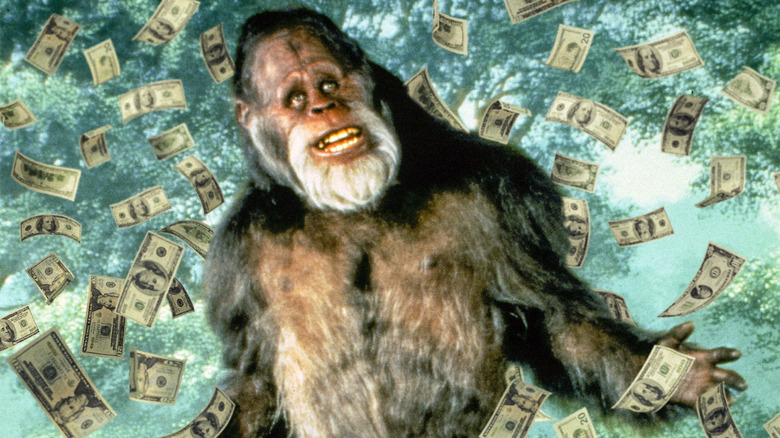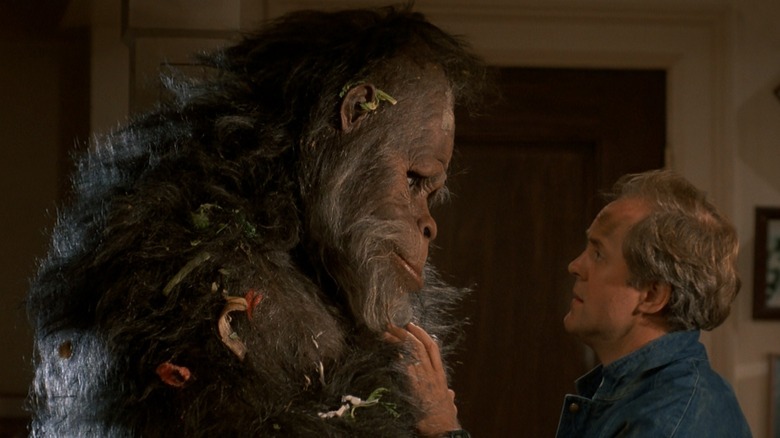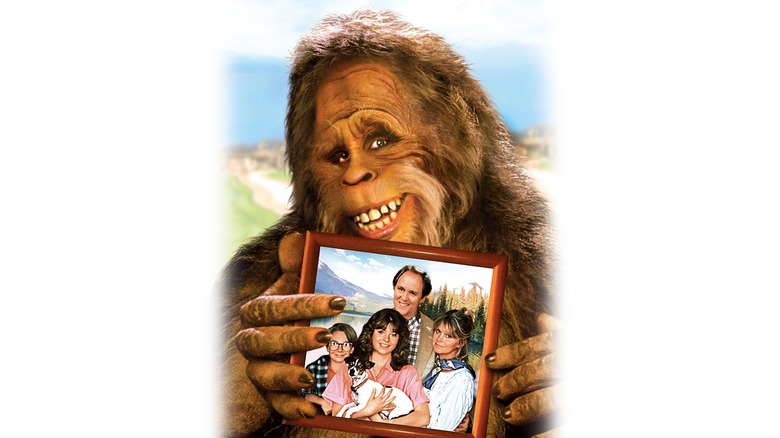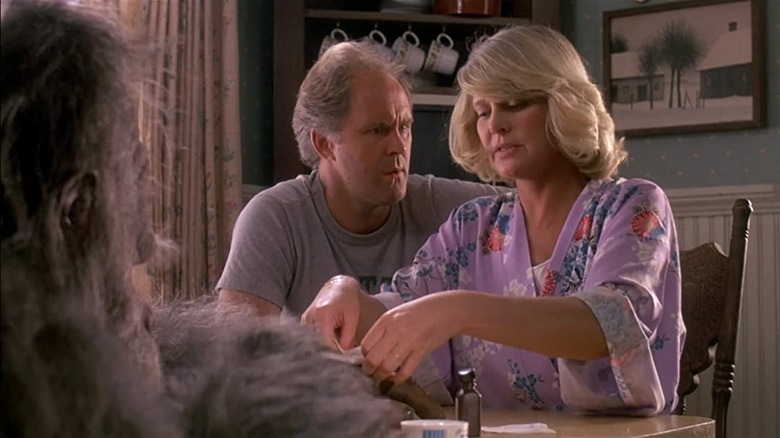Tales From The Box Office: Harry And The Hendersons Is The Only Bigfoot Movie That Ever Made Any Money
(Welcome to Tales from the Box Office, our column that examines box office miracles, disasters, and everything in between, as well as what we can learn from them.)
From the earliest days of popular cinema, monsters have been a big draw for audiences. Just look at the classic Universal Monsters films, such as "Dracula," "Frankenstein," and "The Wolfman." And yet, after all these years, we have yet to have a true, blue breakout Bigfoot movie — at least, not of the horror variety anyhow. Sure, there have been near countless direct to DVD Bigfoot films such as "Abominable" or "Exists" that have tried to do the job, but those only ever get you so far. To date, some 35 years later, it is remarkably the family-friendly comedy "Harry and the Hendersons" that has left the biggest mark on popular culture in terms of cinematic interpretations of the legendary creature.
That being the case, in honor of the 1987 film's 35th anniversary this week, we're looking back at "Harry and the Hendersons," how its modest success inspired a pretty popular TV show, how it seems like the least likely kind of Bigfoot movie to actually find success, and what lessons might be gleaned from its success all these years later. Let's dig in, shall we?
The Movie: Harry and the Hendersons
Oftentimes in this column, I find myself having to cut myself off as the movies I choose to write about could fill a novel in terms of interesting behind-the-scenes information and whatnot. What's kind of remarkable about "Harry and the Hendersons" 35 years removed is just how unremarkable it was for its time. It was a pretty basic (for its time) family-friendly studio film at a time when families had far fewer option, featuring a damn decent cast led by Jon Lithgow alongside Kevin Peter Hall as the titular Harry. VCRs were popular at this time but, barring that, going to the movies was one of the most viable activities a family could hope for at that time.
Studios were able to program films with that in mind. Movies could play in theaters for far longer at this time. Not topping the box office on your opening weekend was far from a death sentence. And even if a movie failed to make its money back in theaters, there was a burgeoning home video business that could bail you out after the fact. It is exactly this line of business-minded thinking that got "Harry and the Hendersons" made. It was not meant to be a remarkable thing — and quite frankly it wasn't. The caveat to that is the Bigfoot, aka Harry, created for the film, which was cooked up by legendary effects artist Rick Baker, who actually won an Oscar for his work on the film. Beyond that though, it just so happens to be, for whatever reason, the only mainstream movie about Bigfoot that ever made enough money to matter. That is kind of remarkable.
William Dear, whose feature credits up to that point included "Northville Cemetrry Massacre" and "Timerider: The Adventure of Lyle Swann," was tapped to write and direct the movie which, very basically, centers on the Henderson family adopting a sasquatch as they try to keep him a secret whilst going about their normal lives. Spoilers: it does not go well. Hailing from Universal Pictures and Amblin Entertainment, this PG Bigfoot flick was part of the studio's summer offerings that year, and it managed to become a solid hit, if not one that warrants a great deal of discussion in the annals of cinema history.
The financial journey
"Harry and the Hendersons" kicked off its theatrical run on June 5, 1987, square in the heart of a robust summer moviegoing season. It made a decent $4.1 million that weekend, coming in third behind "Beverly Hills Cop II" and "The Untouchables." The movie would never climb any higher up the chart, falling to number six the following weekend and all the way to number 12 come the Fourth of July weekend. Be that as it may, "Harry and the Hendersons" managed to let out to $29.7 million domestic and $20.2 million worldwide for a $49.9 million total. That is just a hair shy of $50 million, which would represent five times its reported $10 million budget. A straight-up win if ever there were such a thing in the movie business.
I'm not often one to get caught up in the inflation game as it relates to the box office, but in this case it is worth pointing out that, adjusted to 2022 dollars, the movie would have made around $127 million, give or take. If that actually happened against a reasonable budget we would be on the verge of a "Harry and the Hendersons" cinematic universe. While that didn't happen at the time, a TV show of the same name did make it to air in 1991 and ran for an impressive 72 episodes across three seasons. (Again, an illustration of the times as 24 episode seasons were common back then.)
Universal had itself a fine theatrical hit, a home video winner, and a TV spin-off to go with it. Again, by any studio's line of thinking even today, that is where the goalposts are. And yet, it's not as though "Harry and the Hendersons" is talked about a great deal these days. It was a hit that came and went. It did its thing and we, as a society, moved on.
The lessons contained within
So, what lesson can be extracted from the success of "Harry and the Hendersons," a movie likely described by most people who remember it as, "Oh yeah, I remember that movie" before moving on with the rest of their day? For me, it's a simple one (and no, I am not trying to be funny here): why the f*** hasn't anyone made another Bigfoot movie for a major studio in the past 35 years? Seriously. If a family-friendly take on a creature that has endured in the pop culture landscape at least since 1967 when the infamous Patterson-Gimlin film surfaced, why was this the only movie to make any money worth mentioning?
This very website is home to a list ranking 47 (yes, 47!!) different Bigfoot movies and yet, almost all of them were given such minimal releases that they failed to capture any attention in the greater public consciousness. We've had valiant (if frustrating) efforts such as 2013's "Willow Creek" but that movie, all due respect, made pennies. Where is Blumhouse at in this regard? One doesn't need rights for Bigfoot. You can just make a modestly budgeted Bigfoot movie at the studio level, treat it seriously, and see what happens. It is genuinely amazing to me that this hasn't happened, and that the high water mark remains "Harry and the Hendersons" even if we don't account for inflation.
I am no filmmaker. I am merely a guy who writes about this stuff. But, to me, in an era when every studio is looking for IP or recognizable figures to generate movies and/or TV shows that people will pay attention to, Bigfoot is sitting right there, waiting to be taken seriously. Do your thing, Hollywood.



